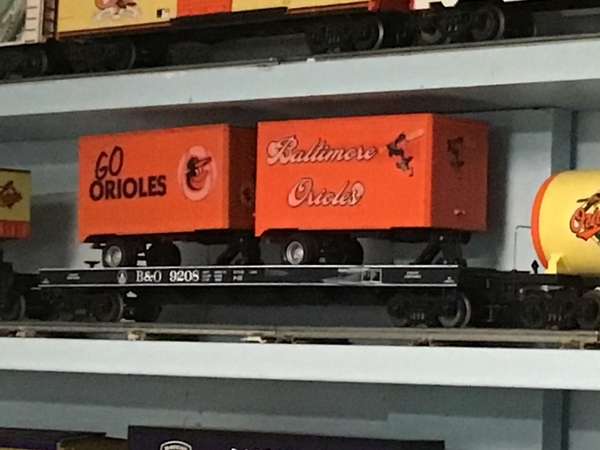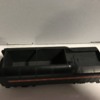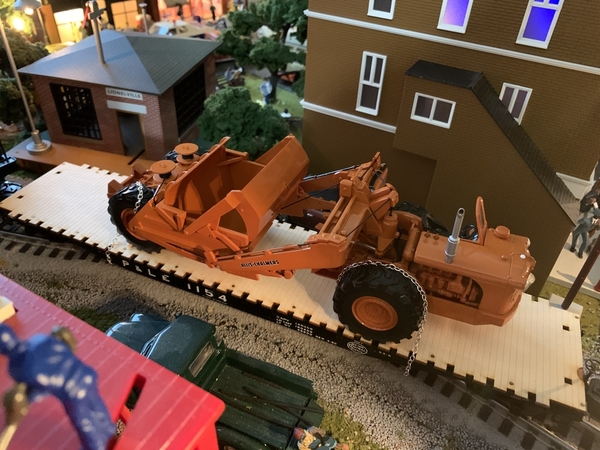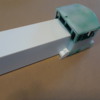A work in progress: Using leftover bits to make a trolley sprinkler car.
Great Job Rob. Super details
Charlie
Attachments
@Nick R. posted:
Nice work, Nick! That’s one fine set.
Attachments
Alumina Covered Hopper Car
I worked for ALCOA in plants that made alumina, or aluminum oxide from bauxite. Therefore I was interested in having covered hopper cars with their locos on. Lionel made two, one for ALCOA and another for Reynolds Aluminum that ALCOA purchased in 2000. Before I found an Lionel ALCOA car to buy, I made an ALCOA covered hopper car from an open hopper car by making a cover from sheet balsa wood and adding an ALCOA sticker.
Then a Lionel ALCOA covered hopper car was found.
Charlie
Scratch built, freelance Garratt. Except for the running gear (Industrial Rail PRR E6 4-4-2's) and the Weaver scale 40' flat car as the "girder" for the boiler, it's all basswood and styrene and bits.
Man, if you think a typical Mallet has joints and connectors and swiveling parts, you should build one of these!
I was always surprised that MTH never offered a big modern Garratt while they were offering their non-North American steamers. Maybe because most of them were less-than-standard gauge locos. 3.5 feet was common, as in S. Africa, so O-gauge track would have been wrong. I would have bought it anyway.
Attachments
This was an idea my father and I had about 20 years ago. Modify a tender--a cheap one!--by removing the imitation coal pile and creating a bin that can be filled by a Lionel Coal Loader or Prewar Coal House. More than a few pieces of coal miss their mark, but that's just the Lionel way. My father decided to make the bin removable for easier refilling of the Coal House. The bin is fashioned from thin sheet metal--in addition to being a master plumber, my dad was skilled at fashioning ductwork.
Attachments
@D500 posted:Scratch built, freelance Garratt. Except for the running gear (Industrial Rail PRR E6 4-4-2's) and the Weaver scale 40' flat car as the "girder" for the boiler, it's all basswood and styrene and bits.
Man, if you think a typical Mallet has joints and connectors and swiveling parts, you should build one of these!
I was always surprised that MTH never offered a big modern Garratt while they were offering their non-North American steamers. Maybe because most of them were less-than-standard gauge locos. 3.5 feet was common, as in S. Africa, so O-gauge track would have been wrong. I would have bought it anyway.
I forwarded this to a friend of mine who's a fan of Garratts, and he said:
Fellows Great work on the Garrett and Lionel coal tender with removable coal bin. I need to make a coal tender mod with removable bin.
I will have to find out more about that Garrett engine, sure looks different than normal.
Charlie
The Beyer Garratt is absolutely amazing!! It has long been on my wish list to see it made in O by either Lionel or MTH. I have often thought of building one myself in a fashion similar to the method you used. Thanks for showing it to us.
corsair29
Very neat and attractive locomotive. Like the Garrett, above yours, I am not familiar with your #78, please tell me what type it is.
Charlie
@Choo Choo Charlie posted:corsair29
I am not familiar with your #78, please tell me what type it is.
Attachments
Admittedly, not a glitzy modification, but I wanted to improve two lowly Lionel 520 Boxcabs. I drilled out the headlight nacelles and installed lamps and lenses, added a rooftop horn to both, and installed a Lionel sound circuit board and speaker in the non-powered 520. I use this pair to pull a track cleaning car around my layout. Photo attached.
Mike Mottler LCCA 12394
Attachments
@Mike H Mottler posted:Admittedly, not a glitzy modification, but I wanted to improve two lowly Lionel 520 Boxcabs. I drilled out the headlight nacelles and installed lamps and lenses, added a rooftop horn to both, and installed a Lionel sound circuit board and speaker in the non-powered 520. I use this pair to pull a track cleaning car around my layout. Photo attached.
Nice job! I used a 520 shell as the basis for the Crocodile...
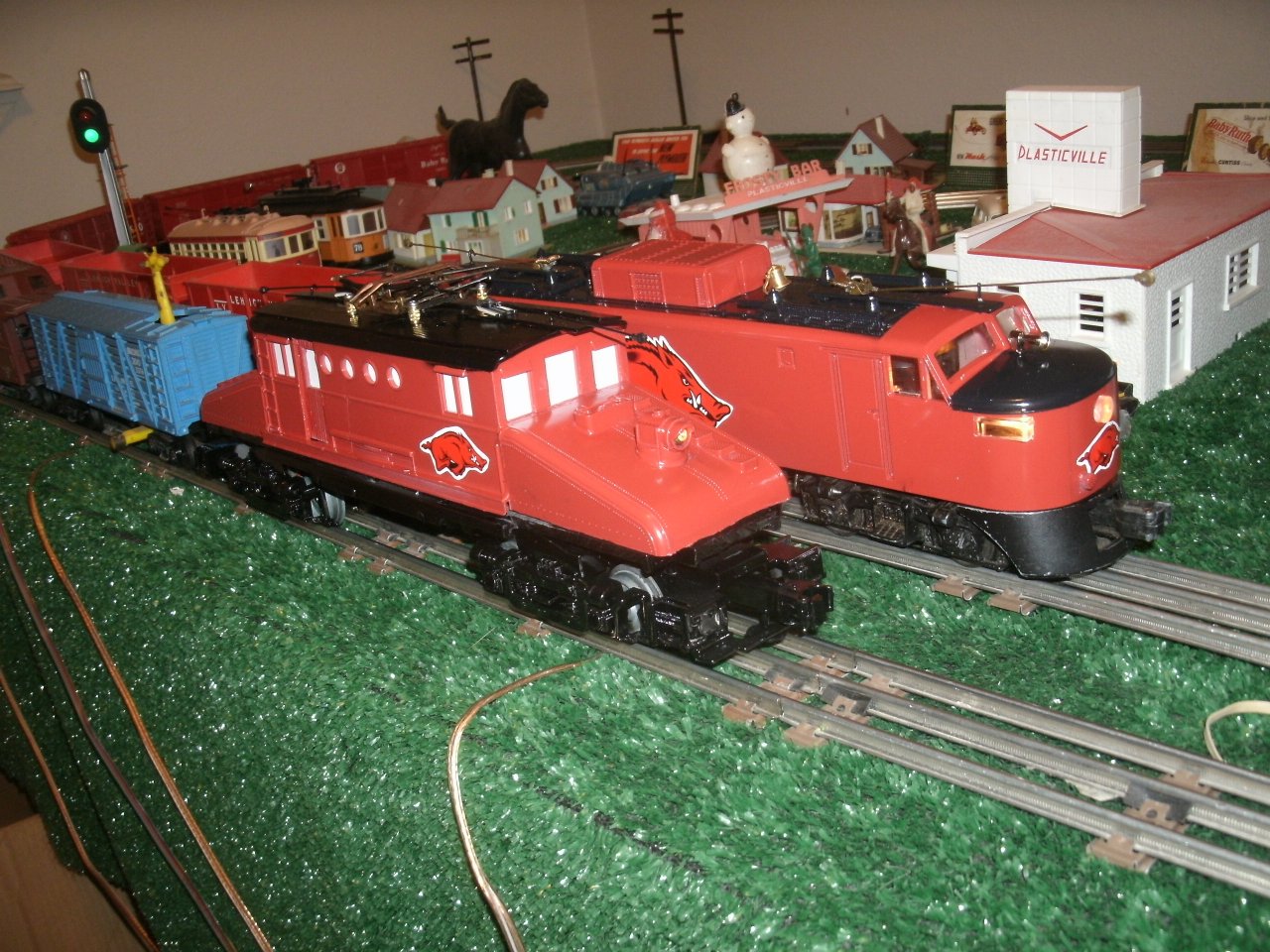
Mitch
@M. Mitchell Marmel posted:I forwarded this to a friend of mine who's a fan of Garratts, and he said:
Love it! That's a killer!I will point out to you that New South Wales had plenty of Garretts that ran on standard gauge.Also, a lot of South African models are sold to run on standard gauge HO track, also some offer a choice of that or standard TT gauge, which equates to South Africa's 3'6" in HO scale.Mitch
All the kind words are appreciated. I did not know/had forgotten that there were some Standard Gauge Garratts in Australia. I got a book on Garratts years ago, lots of color photos, and I just had to have one, even though "mine " never existed. I was actually inspired at first by a French 4-6-2+2-6-4 - streamlined, no less (of course it was - it was French).
I suppose I should have said "2-3-1+1-3-2". It was beyond me, but I did what I could.
Mike
Great job dressing up the Lionel 520s, they need lots of help in the looks department.
I saved your picture as a references as I want to dress up my boxy 520 too. Mine does not even have a wire pick up on the roof. It is mostly a wall flower now.
Charlie
Just to plant another idea with you, look up Kitson-Meyer locomotives - interesting beasts. This is from David Argent's YouTube channel, showing several of his unique projects.
Does G Scale count?
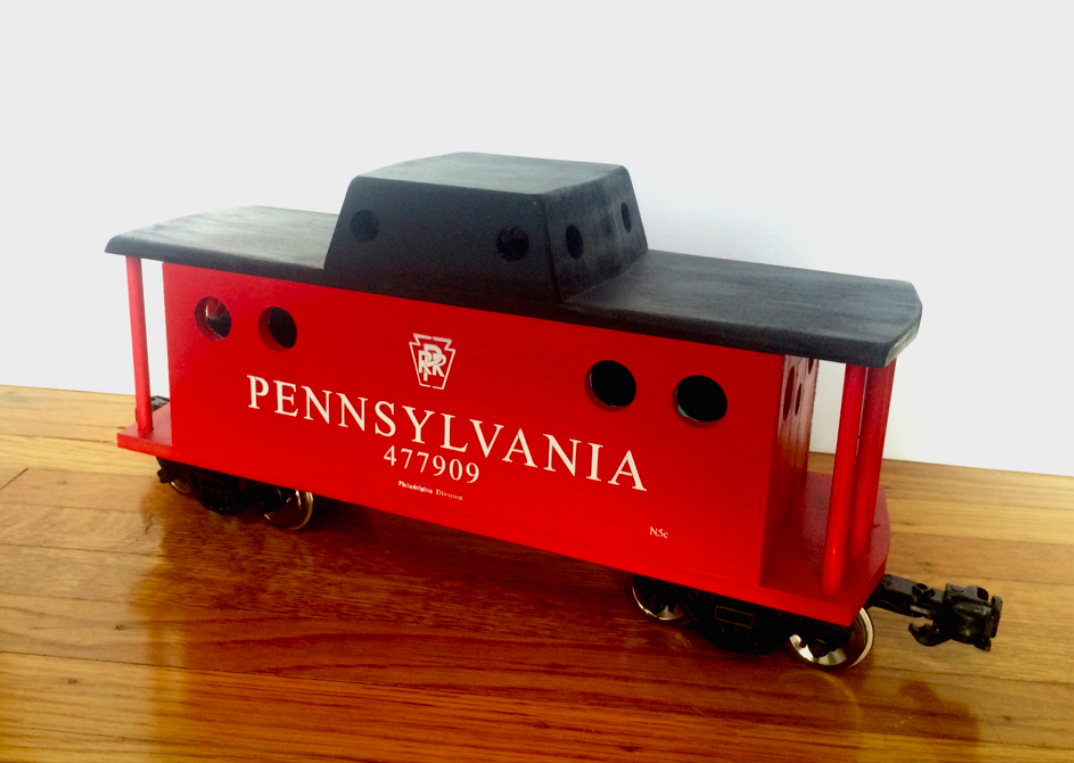
Not the greatest picture but here is a PRR N5c cabin car I build during high school. The trucks are aristocraft but everything else is build from MDF. We had a laser cutter which I used to create the stencils for the lettering on the sides. My one regret was not squaring the windows on the cupola like the prototype has; I wasn't the best at chiseling at the time. I may correct this at somepoint and add steps but don't want to ruin what I already built.
First pic is a window reconfigured Williams Madison which started out like the original shown in the second photo. The arched window treatments follow the prototype and were free-handed styrene inserts. On the next 3 cars I do, I will be using laser cut pieces instead! This was a trial-and-error work.
Terry
Attachments
It would make more sense to call it "Scratchbuilt" or "Kit-bashed" in my opinion. It would just sound more model railroady ![]()
My current rusty scrapyard gondola project. Basic flat spray paints--black, brown, some camo green, red primer. White or wood glue for the bulges. I will touch it up with Dr. Ben's Scale Consortium weathering paints to give it a less "uniform" rusted look.
Attachments
I think most slugs, if not all, were converted from complete diesels. A lot of I have seen did not have cabs. I lived near Conway yards on the old Pennsy when I was a bit younger, and there were a number of slugs, sometimes 2, paired with a mother unit working the hump. These looked like cut down RSD12s, or maybe RSD7/15. They had no cab, but obvously Alco hood units with the hoods cut down to about 4 feet. I understand they would have large concrete ballast in the hoods.
On the other hand, since I have lived in Ohio, and near Northwestern Ohio, I have seen a lot of CSX slugs on local trains. These were generally ex-GP30 or GP35 units paired with a GP40. These slugs all had cabs and I understand they had all controls too. I was told the crews liked to run the set from the slug because it was much quieter than the diesel unit. All these slugs had all the vents for radiators, dynamic brakes, or whatever closed off. Also I think fans on roofs were mostly gone, but not sure. But they still looked like what they started as. It was nice to a GP30 body (slug) on the front end of a short local train trundling along just like when it was a mainline loco.
@CBS072 posted:
Using the U-boat chassis and such left over from my steeplecab project, unless I'm mistaken... ![]()
https://ogrforum.ogaugerr.com/...cab-for-only-pennies
Mitch
I have three locos that are bashed/converted Lionel Lionchief Plus locos. The two in the photo below were both Lionchief Plus traditional size (semi-scale) steamers. I converted them to models of scale steamers by: a) measuring their drivers, wheelbase, etc., and then finding an ATSF steamer in the steamlocomotive.com database with the same number of drivers that matched those dimensions at 1:48 scale, then b) removing the body and building a new body, adding or deleted pilot wheels and such, as needed, at a scale 1:48 of that prticular loco. Similarly rebuilt a new tender body for each. The most obvious change on each is a bigger cab on both (its about 3/8 inch taller in both cases). I particularly like 1856, but 3158 is a good runner and a nice size little loco for my layout.

The top loco in the photo below is a stock-as-a-stone Vision 2-10-10-2 ATSF 3000, just included for size purposes. The bottom loco, 1171, has the chassis from two Lionchief Plus steamers (both with the same road # so they respond to the same remote), and a scratchbuilt 1:48 scale body for ATSF 1171. A bit before 3000 was built, ATSF built 1171 and a few other bendable boiler articulated locos. Santa Fe experimented with two different ways to make a long boiler on an articulated loco bend. Both types of locos ran well but the flexible boiler joint was a monstrous maintenance headache. 1171 was eventually disassembled and rebuilt as two 2-6-2s.

Attachments
As with the Dew decal/logo, I got them on ESTY I think. Anyway, I just googled Mt. Dew gifts. (there were tons of stuff)!
@dkdkrd posted:As clever and well thought out as the tender modification is, the very best part of this is having your dad be an active part of the hobby and a creative contributor. I would easily consider that tender falling into the "Priceless" category.
You are VERY blessed, indeed!!
KD
KD,
Thanks for the kind comment! You hit it right on the head--this hobby has connected me and my father for more than 40 years. Lionel was spot on its marketing about the power of hobbies like this to bring fathers and sons together. On that note, it is terrible how COVID-19 has "stolen" train shows from us, because that has been another great source for creating social connections with others for myself and my father.
All the best!
John
@Lee Willis posted:The top loco in the photo below is a stock-as-a-stone Vision 2-10-10-2 ATSF 3000, just included for size purposes. The bottom loco, 1171, has the chassis from two Lionchief Plus steamers (both with the same road # so they respond to the same remote), and a scratchbuilt 1:48 scale body for ATSF 1171. A bit before 3000 was built, ATSF built 1171 and a few other bendable boiler articulated locos. Santa Fe experimented with two different ways to make a long boiler on an articulated loco bend. Both types of locos ran well but the flexible boiler joint was a monstrous maintenance headache. 1171 was eventually disassembled and rebuilt as two 2-6-2s.
Oh, thank goodness - now I don't have to build a "jointed boiler" ATSF articulated. You have. It looks sharp. ATSF articulateds are on a planet of their own, anyway. In a good way.
How about a thread on your loco with up-close photos. I want to see the joint, especially.
(For those who are unfamiliar, the ATSF jointed "boiler" wasn't really quite that, though that is the common term for it. The actual boiler was the rear section, and the front was a large feed water heater/re-heater. I forget the exact arrangement; I need to get out one of my Santa Fe books.)
@M. Mitchell Marmel posted:Using the U-boat chassis and such left over from my steeplecab project, unless I'm mistaken...

https://ogrforum.ogaugerr.com/...cab-for-only-pennies
Mitch
Yes, Mitch that is the trucks and fuel tank from the U-boat but not the frame.
The U-boat frame was too short, So I built a frame from 2" x 1/4" aluminum and styrene.
The body is styrene and a cab from a K-line KCC MP15.
I plan to have the slug at the club's first meeting in a few months for "show and tell".
Attachments
@D500 posted:Oh, thank goodness - now I don't have to build a "jointed boiler" ATSF articulated. You have. It looks sharp. ATSF articulateds are on a planet of their own, anyway. In a good way.
How about a thread on your loco with up-close photos. I want to see the joint, especially.
(For those who are unfamiliar, the ATSF jointed "boiler" wasn't really quite that, though that is the common term for it. The actual boiler was the rear section, and the front was a large feed water heater/re-heater. I forget the exact arrangement; I need to get out one of my Santa Fe books.)
I'm pretty sure Lee articulated that build. heh heh. This forum or another.






